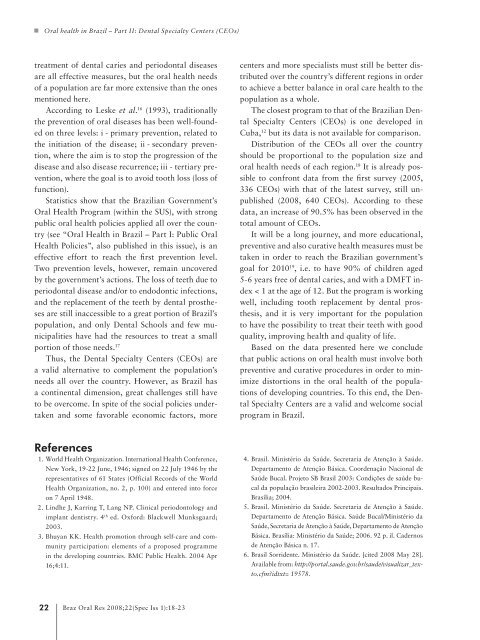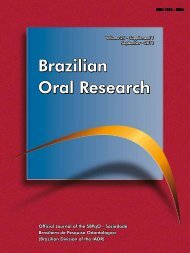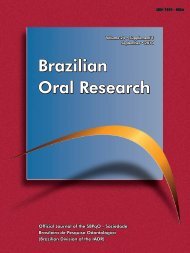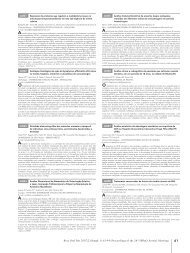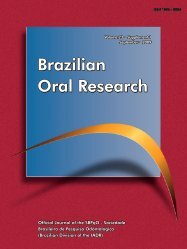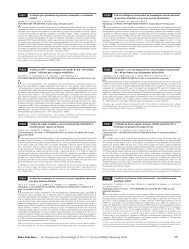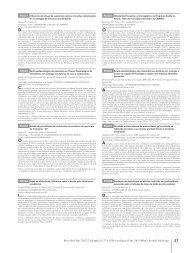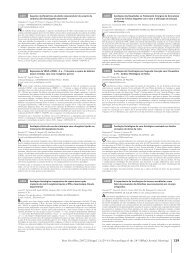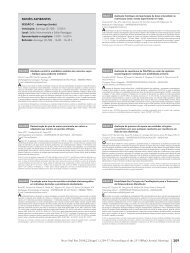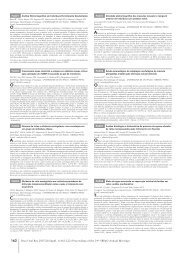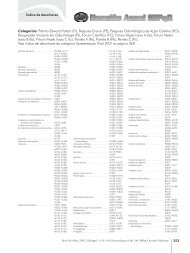Brazilian Oral Research Brazilian Oral Research Brazilian Oral
Brazilian Oral Research Brazilian Oral Research Brazilian Oral
Brazilian Oral Research Brazilian Oral Research Brazilian Oral
Create successful ePaper yourself
Turn your PDF publications into a flip-book with our unique Google optimized e-Paper software.
<strong>Oral</strong> health in Brazil – Part II: Dental Specialty Centers (CEOs)<br />
treatment of dental caries and periodontal diseases<br />
are all effective measures, but the oral health needs<br />
of a population are far more extensive than the ones<br />
mentioned here.<br />
According to Leske et al. 16 (1993), traditionally<br />
the prevention of oral diseases has been well-founded<br />
on three levels: i - primary prevention, related to<br />
the initiation of the disease; ii - secondary prevention,<br />
where the aim is to stop the progression of the<br />
disease and also disease recurrence; iii - tertiary prevention,<br />
where the goal is to avoid tooth loss (loss of<br />
function).<br />
Statistics show that the <strong>Brazilian</strong> Government’s<br />
<strong>Oral</strong> Health Program (within the SUS), with strong<br />
public oral health policies applied all over the country<br />
(see “<strong>Oral</strong> Health in Brazil – Part I: Public <strong>Oral</strong><br />
Health Policies”, also published in this issue), is an<br />
effective effort to reach the first prevention level.<br />
Two prevention levels, however, remain uncovered<br />
by the government’s actions. The loss of teeth due to<br />
periodontal disease and/or to endodontic infections,<br />
and the replacement of the teeth by dental prostheses<br />
are still inaccessible to a great portion of Brazil’s<br />
population, and only Dental Schools and few municipalities<br />
have had the resources to treat a small<br />
portion of those needs. 17<br />
Thus, the Dental Specialty Centers (CEOs) are<br />
a valid alternative to complement the population’s<br />
needs all over the country. However, as Brazil has<br />
a continental dimension, great challenges still have<br />
to be overcome. In spite of the social policies undertaken<br />
and some favorable economic factors, more<br />
References<br />
1. World Health Organization. International Health Conference,<br />
New York, 19-22 June, 1946; signed on 22 July 1946 by the<br />
representatives of 61 States (Official Records of the World<br />
Health Organization, no. 2, p. 100) and entered into force<br />
on 7 April 1948.<br />
2. Lindhe J, Karring T, Lang NP. Clinical periodontology and<br />
implant dentistry. 4th ed. Oxford: Blackwell Munksgaard;<br />
2003.<br />
3. Bhuyan KK. Health promotion through self-care and community<br />
participation: elements of a proposed programme<br />
in the developing countries. BMC Public Health. 2004 Apr<br />
16;4:11.<br />
22<br />
Braz <strong>Oral</strong> Res 2008;22(Spec Iss 1):18-23<br />
centers and more specialists must still be better distributed<br />
over the country’s different regions in order<br />
to achieve a better balance in oral care health to the<br />
population as a whole.<br />
The closest program to that of the <strong>Brazilian</strong> Dental<br />
Specialty Centers (CEOs) is one developed in<br />
Cuba, 12 but its data is not available for comparison.<br />
Distribution of the CEOs all over the country<br />
should be proportional to the population size and<br />
oral health needs of each region. 18 It is already possible<br />
to confront data from the first survey (2005,<br />
336 CEOs) with that of the latest survey, still unpublished<br />
(2008, 640 CEOs). According to these<br />
data, an increase of 90.5% has been observed in the<br />
total amount of CEOs.<br />
It will be a long journey, and more educational,<br />
preventive and also curative health measures must be<br />
taken in order to reach the <strong>Brazilian</strong> government’s<br />
goal for 2010 19 , i.e. to have 90% of children aged<br />
5-6 years free of dental caries, and with a DMFT index<br />
< 1 at the age of 12. But the program is working<br />
well, including tooth replacement by dental prosthesis,<br />
and it is very important for the population<br />
to have the possibility to treat their teeth with good<br />
quality, improving health and quality of life.<br />
Based on the data presented here we conclude<br />
that public actions on oral health must involve both<br />
preventive and curative procedures in order to minimize<br />
distortions in the oral health of the populations<br />
of developing countries. To this end, the Dental<br />
Specialty Centers are a valid and welcome social<br />
program in Brazil.<br />
4. Brasil. Ministério da Saúde. Secretaria de Atenção à Saúde.<br />
Departamento de Atenção Básica. Coordenação Nacional de<br />
Saúde Bucal. Projeto SB Brasil 2003: Condições de saúde bucal<br />
da população brasileira 2002-2003. Resultados Principais.<br />
Brasília; 2004.<br />
5. Brasil. Ministério da Saúde. Secretaria de Atenção à Saúde.<br />
Departamento de Atenção Básica. Saúde Bucal/Ministério da<br />
Saúde, Secretaria de Atenção à Saúde, Departamento de Atenção<br />
Básica. Brasília: Ministério da Saúde; 2006. 92 p. il. Cadernos<br />
de Atenção Básica n. 17.<br />
6. Brasil Sorridente. Ministério da Saúde. [cited 2008 May 28].<br />
Available from: http://portal.saude.gov.br/saude/visualizar_texto.cfm?idtxt=<br />
19578.


